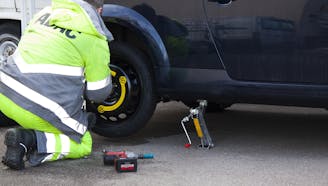
Smart Driving Tips to Safely Maneuver Winter Weather
How to prepare yourself and your vehicle for ice, snow and winds.

The National Highway Traffic Safety Administration (NHTSA) estimates that 17% of all vehicle crashes occur during winter weather. This number could trend even higher this holiday season as more people hit the road in their vehicles instead of boarding airplanes. Whether you're road tripping or just going shopping, don't zip up your luggage or head out the door until you review these tips for safely maneuvering winter road conditions.
Before You Turn the Key
Don't wait till you're behind the wheel to figure out how to drive on icy roads or during heavy snowfall. A short time spent preparing for driving on slick roads could give you greater confidence behind the wheel.
Prepare Your Vehicle
Check the following to make sure your vehicle is prepared for the winter weather:
- Battery: Is it fully charged?
- Ignition system: Can you see any damage?
- Lights: Do they all work? Are the lenses clean?
- Brakes: Have the breaks been squeaking or do they feel mushy?
- Tires: Are they properly inflated? Are the treads clear? Are snow chains in the trunk?
- Exhaust system: Are there any visible leaks?
- Heating and cooling system: Is the antifreeze at the proper level? Can you see any leaks?
- Windshield wiper system: Are the blades worn? Is the reservoir full with a winter blend or washer solvent?
Some checks and service may require the assistance of a qualified mechanic.
Pack a cold-weather emergency kit that includes a flashlight with extra batteries, blankets, gloves, an ice scraper, and a cell phone charger. The kit should also include food items, such as energy bars and bottled water, which can help keep you energized and hydrated if you encounter weather-related delays.
Prepare Yourself
Your vehicle isn't the only thing that needs to be prepared for winter weather conditions. While you prepare your vehicle for the road, you must also prepare yourself, both physically and mentally.
- Accept that you must give yourself more time to reach your destination and drive slower. Visibility, traffic, and road conditions will all play a part in how slowly you must drive.
- Dress in layers to protect yourself from freezing temperatures, but expect to remove some if you plan on driving long distances. Your vehicle's heating system should provide enough heat that you can remove some of your clothing. Removing some of the bulk can make your drive more comfortable. Wait to take off jackets, sweaters, or other clothing until you've parked in a safe area.
- Check mirrors and seat positioning once more after you've buckled your seat belt. Adjust your seat so there is at least ten inches of space between your chest and the steering wheel.
- Let at least one friend or relative know where you're going and when you should arrive.
- Contact your auto insurance carrier to confirm your coverage and roadside assistance benefits.
Review the weather forecast before you leave home so you'll know what to expect. In some instances, you might need to reschedule a trip.
Driving Techniques for a Smooth Ride
Weather conditions can turn on a dime during the winter, but your ability to adjust might take longer. When you approach a new weather environment, be sure to:
- Avoid using cruise control, even at a low speed.
- Increase the distance between you and the vehicle in front of you, preferably by at least 5 seconds.
- Slow down to allow your tires to gain traction.
- Accelerate slowly to avoid skidding or losing control of the vehicle.
Read your vehicle owner's manual to confirm whether you have anti-lock brakes. This will determine how best to apply your brakes when driving on slippery surfaces. The manual may also include other model-specific safety tips to help you stay safe while driving in bad weather.
Park and Prepare
Once you arrive at your destination, check the vehicle for damage that may have occurred during the drive. Pay particular attention to exhaust pipes, checking for snow, ice, or mud, since clogged pipes can cause dangerous carbon monoxide to enter the vehicle passenger compartment. Check the items under the Before You Turn the Key section again before you head back home.
Winter snow and hazardous driving conditions aren't the only things to watch out for this season. Make sure you have adequate car insurance to protect your finances if an accident occurs. Don't wait until you have to file a claim to learn that your deductible is too high, or your policy limits are too low. Speak to Branch today to learn about your insurance options.




